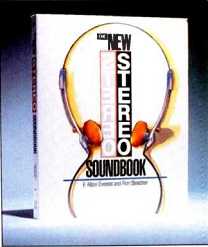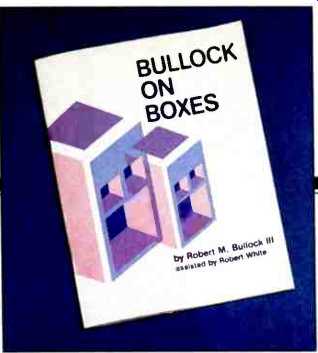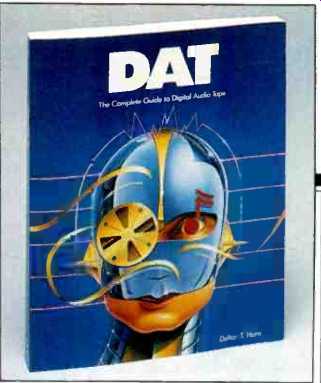A+ FOR ACOUSTICS
The New Stereo Soundbook
by F. Alton Everest and Ron Streicher. TAB Books Division of McGraw-Hill, softcover, 283 pp., $18.95

I strongly recommend this excellent volume. Everest and Streicher provide a most interesting historical overview of stereophony, followed by a thorough examination of how our hearing system enables us to localize sound, both live and stereophonically reproduced.
Only after introducing these auditory concepts do the authors examine microphone placement techniques at the recording end of the stereo chain and the implementation of multi-dimensional stereo and surround sound at the playback end.
An acknowledgment at the beginning of The New Stereo Soundbook mentions that the manuscript was read by none other than Floyd E. Toole, a longtime researcher of audio phenomena who spent many years at the National Research Council, Division of Physics, in Canada and who recently joined JBL as a research scientist.
Anyone familiar with Dr. Toole's work will agree that if he found no scientific errors in the manuscript, it is accurate.
In addition to this volume's 14 chapters, there is a 19-page appendix that relates specific paragraphs of A. D. Blumlein's 1933 British patent to just about every aspect of stereophonic recording and reproduction. Anyone interested in stereo should find the work of this early pioneer fascinating. Blumlein's death in an airplane crash in Britain during World War II cut short a brilliant career during which he was granted some 128 patents. This appendix, and the complete chapter-by chapter reference and bibliography section, are worth the price of the book alone. The glossary defines many terms that, I venture to say, even the most experienced audio enthusiast may not have encountered before or, if he has, may not have properly or completely understood.
The main chapters explore stereo sound from various aspects. First, the authors explain the directional encoding of sounds falling on the ear and how interaural differences in these cues provide spatial texture to stereo images. Two chapters are devoted to the philosophical and pragmatic implications of stereo production techniques, while five chapters examine modern stereo microphone practices in great detail. Other chapters cover auditory spaciousness, coloration of sound, and perhaps most important to readers of Audio, optimization of the listening environment.
All too many audio enthusiasts spend large sums of money and a great deal of time in selecting electronic equipment, but relatively few, it seems, devote enough effort in improving the acoustics of the room where they do their listening. Chapter 14 is one of the best treatises (however abbreviated) on room acoustics that I have ever read and should be required reading for professional audio practitioners and serious audiophiles as well. I chuckled at the second paragraph of this chapter: "Long ago a child defined salt as 'something that makes potatoes taste bad if you don't put any on.' Acoustics makes music sound bad if nothing is done to correct it." From that starting point, Everest and Streicher lead the reader through such subjects as axial-mode resonance, tangential and oblique resonance modes, the mid/high-frequency region and delay effects, reflections in the listening room (and their effects), diffusion of sound, stereo geometry, and room treatment (for bass and the mid/high-frequency region). One chapter that particularly fascinated me was "Multidimensional and Surround Sound Systems." In tracing the history of multi-channel sound, the authors show why the various matrix and discrete quadraphonic systems of the 1970s failed and how they eventually gave rise to the surround and ambience systems many of us currently enjoy. In dealing with multi-directional sounds from the perspectives of both production and playback, the authors give us greater understanding of just what it is we perceive when we listen to music played back using Ambisonics, Dolby Surround, Shure's HTS Stereo surround, and the like.
The New Stereo Soundbook includes instructions on easy-to-follow experiments and all the diagrams, tables, and photographs you need to enhance, improve, and modify your stereo system. If you read this book from cover to cover, you should be able to use microphones to achieve satisfactory special stereo effects. You will know how to record signals binaurally with the use of a dummy head.
You will understand how to create a stereo signal from two or more monophonic signals and how to control sound reflections for optimal stereo listening. I would hasten to add that if you have a phobia about those complex mathematical formulas that have a way of cropping up in many texts on sound and acoustics, put your fears aside.
The authors present all their material in nonmathematical terms while at the same time conveying all the concepts that are necessary for a better understanding of their subject matter.
Once you've read this book you will have a more complete understanding of stereophonic sound. And that increased understanding will, in turn, provide you with greater enjoyment of your stereo equipment, be it modest in price and complexity or at the super high end.
-Leonard Feldman
Bullock on Boxes
by Robert M. Bullock III, assisted by Robert White. Audio Amateur Press, paperback, 74 pp., $10.95.

It has been my observation over the years that almost everyone who is interested in the technical aspects of sound reproduction is especially intrigued by the mysteries of loudspeaker design. I am often asked for good reference materials such as books and magazine or technical journal articles that explain some of these mysteries.
There are a few good books, but the main sources of information are the Journal of the Audio Engineering Society (JAES) and Speaker Builder magazine. Each monthly issue of the JAES usually contains technical reports covering various theoretical aspects of loudspeaker design and measurement written by and directed to professional engineers. The articles in Speaker Builder are written by both professionals and amateurs, and they are more concerned with the practical aspects of building and measuring loudspeaker systems.
Robert M. Bullock III has written a large number of articles about loudspeaker design, intended to help amateurs build systems that will compare favorably with commercially offered products. He is a professor of Applied Mathematics and Statistics at Miami University, Oxford, Ohio and has brought some of his mathematical expertise to his hobby, which is designing and building loudspeaker systems.
Bullock on Boxes is a compilation of articles, dealing with vented or ported loudspeaker design, which appeared in Speaker Builder magazine during the 1980s. The material in the book is based on the work published by A. N. Thiele in Australia, which appeared in the JAES Vol. 19 (1971), and on refinements by R. H. Small that were published in the JAES Vol. 21 (1973). The work by Thiele and Small is an exposition and elaboration of the concept that a loudspeaker system can be modeled as a high-pass filter, at least in the low frequency range where the loudspeaker diaphragm acts as a piston. This idea was also proposed by James F. Novak in IRE Transactions on Audio, Vol. AU-7 (1959). The design and implementation of electronic filters has become a very complex field because the theoretical foundation has expanded greatly over the years; Thiele and Small have made good use of highpass filter theory by applying it to the design of speaker systems. They also expanded the idea of using a highpass filter model and came up with different filter alignments by adjusting driver and enclosure design parameters; these alignments came to be known as "Thiele-Small Parameters." The book contains nine chapters, the first four of which are devoted to the design methods, explanations of the theory, and some design examples that use commercially available loudspeaker drivers. Chapter 1 is titled "Thiele, Small, and Vented Loudspeaker Design." Bullock starts by giving the background for the whole idea of using electrical filter design techniques and the use of Butterworth, Chebyshev, and Bessel filters as analogs for different vented box designs. He discusses the five main loudspeaker driver parameters that are used in the design formulas: RE, the d.c. resistance of the driver's voice-coil; fs, the driver's resonance in free air without a baffle or enclosure; °ES, the electrical part of the "CT or quality factor of the driver at its free air resonance (fs); QMs, the mechanical part of the "O" of the driver at fs, and the VAS, which is the compliance of the driver's suspension expressed as the compliance of an equivalent volume of air. QTs, the total system "0," is then derived from °ES and QMS. Figures 1 through 6 show output versus frequency response characteristics for various vented box designs so the reader can get a good idea of what filter alignments such as B4 (fourth-order Butterworth) and QB3 (Quasi-third-order Butterworth) look like. Under a subheading titled "Alignments," Bullock explains the use of the ratio parameters "h" and "a" (alpha): h = f8/fs and a = VAs/VB. He then explains the difference between what have come to be known as "Thiele Alignments" and "Small Alignments." The use of the QTs, "h," and "a" parameters are explained and examples are shown in tables. Chapter 1 also includes sidebars for an appendix and references. Since the material for this book is derived from Bullock's articles in Speaker Builder magazine, an interesting twist, for a book, is that comments about the original article from readers and the author's replies are included at the end of this chapter.
Chapter 2 is titled "Determining Design Parameters for Your Loudspeaker." Bullock discusses methods of measuring the parameters of amplifiers that will affect the response of the loudspeaker system, as well as the parameters of the loudspeaker drivers that are necessary to use the Thiele/ Small design methods. For the amplifier measurements, he shows both constant-voltage and constant-current techniques for obtaining parameters. I found the section "Finding fs, QMs, QEs" a little vague and perhaps a bit hurried; I think that it could be expanded by explaining the formulas (7c), (7v), (8c), and (8v) in more detail. The practical aspects of the test equipment and details of the measurements and things to be concerned about are well covered. Another minor quibble I have concerns page 14, where the VAS for Example 1 is calculated using equation (11), which doesn't appear until later in the exposition.
Chapter 3, "Fine Points of Vented Speaker Design," contains an exposition of the practical details that are necessary to design a vented loudspeaker system. To this end, the parameters for two commercially available drivers are used, and complete design information for the bass section of two systems is presented. The effects of design parameters on the response of these systems is shown in 14 graphs; there are also six tables showing various data. Numerous anecdotes about personal experiences with practical designs are also included.
Chapter 4, "Alternate Alignments," is aimed at readers who have gained some expertise from designing their own systems and explores the variations in response that can be obtained by using different alignments for vented systems. There are 19 tables and 15 graphs in the chapter. For readers who wish to try values and possibilities not found in the tables, Chapter 5, "T/S Calculator Programs," shows programs (which can be run on the Texas Instruments TI-59 and Hewlett-Packard HP-97 calculators) for determining response curves of particular vented systems, and includes some design examples.
Chapter 6, "BOX-RESPONSE: An Apple Program for the Thiele/Small Models," and Chapter 7, "Realizing BOX-RESPONSE's Potential," deal with an Apple computer program that can be used to design vented loudspeaker systems. The program was written by Bob White, who also wrote Chapter 7. Another program, called "BOX MODEL," lends its name to the title of Chapter 8; it includes the option of modeling systems that use passive radiators, and examples are shown in this chapter. Chapter 9 consists of letters from readers about the original articles and Bullock's replies. There is an index, a bibliography of related Speaker Builder articles, and a glossary.
Because this book is really a compilation of previously published articles, it doesn't follow a plan of exposition that would be found in a book written from scratch, but it is still very valuable because it provides much information about vented box design in one convenient package. I hope that someday Bullock will find the time to write the definitive book about both vented and sealed loudspeaker system design. He has acquired a great amount of knowledge about vented loudspeakers from designing and building real systems.
Bullock shares this expertise with readers in a very useful way by presenting both the formulas and the measurement techniques, along with good explanations and practical examples of them; the book is also written in the first person and is very friendly. Anyone interested in designing and building vented loudspeaker systems should have a copy.
--Edward M. Long
DAT: The Complete Guide to Digital Audio Tape
by Delton T. Horn. TAB Books Division of McGraw-Hill, softcover, 254 pp., $12.95.

If you want to learn all about the history of sound recording and reproduction by reading the first 48 pages of this book, by all means rush right out and purchase a copy. If you'd like a refresher course on analog sound recording, the basics (and I mean the very basics) of digital recording, and the basics of Compact Disc recordings and how CDs are made, read the next 87 pages or so of Horn's book. You will then have read more than half of this book before the subject of DAT is broached in any depth.
Although the copyright year shown at the beginning of this book is 1991, Horn says that he did the writing during 1990. Unfortunately, he apparently did no revisions after, at best, early 1990. For example, he discusses the Serial Copy Management System (SCMS) as if it were still waiting to be adopted by manufacturers. This, after several pages of rehashing the story of the infamous "copy-code" notch system that was proposed at the very beginning of the DAT controversy and summarily rejected when the National Bureau of Standards confirmed the failings of the system, both sonic and operational. The book also talks about buying DAT recorders on the "gray market," though they've long been fairly widely available in conventional electronics stores.
Normally, in attempting to write a book about such a fast-moving technology as digital audio recording, I would not fault an author for being a bit behind the times. In this case, however, I found the title of the book, as well as its subtitle, "The Complete Guide to Digital Audio Tape," far too misleading. Almost all of Chapter 7 of the book is devoted to a discussion of several automotive playback-only DAT decks. Most of these have been superseded by later generation models. The only two "home" DAT recorders mentioned, for reasons stated earlier, are the Casio DA-2 (which is no longer being sold to consumers) and the Nakamichi 1000 (which, according to my latest pricing information, carries a suggested list price of $11,900). Chapter 8 of the book is entitled "Maintenance and Troubleshooting." After advising the reader not to try to pull tape out of the DAT cassette housing, the author tells us that DATs cannot be edited using manual cut-and splice (razor blade) methods. The author then outlines several problems (e.g., "Problem-cassette cannot be inserted into the well. First, double check to make sure you are trying to put the cassette into the recorder right side up...."). This and other problems of similar complexity are then summarized by impressive-looking flow-charts that end with "Call qualified service technician." In discussing the various options, sampling rates, and recording times of DAT, the author doesn't mention that some DAT recorders can record up to four hours on a single tape at reduced sampling rates with reduced audio bandwidth, an option clearly written into the DAT standards.
In Chapter 9, the author conjectures as to the future of DAT. While Horn claims, earlier, to have understood the SCMS system, it is clear from a couple of sentences that he was not adequately briefed as to the limitations of SCMS when he wrote this chapter. He tells us that, "Electronic 'one-man bands' who play all the parts themselves will be able to pass their tapes through as many generations as they need to create elaborate pseudo orchestra recordings, without worrying about noise and distortion buildup." That is not true, since SCMS also permits only one digital-to-digital copy generation for recordings made via the analog inputs. Again, because of the rapid advances in technology that are characteristic of the audio industry, Horn could not possibly have known about the Philips Digital Compact Cassette (DCC), whose technology was revealed in early 1991. Neither could he have predicted the introduction of the MiniDisc developed by Sony and scheduled for introduction in late 1992.
Both of these new formats will undoubtedly have an important bearing on the future of DAT.
In summary, if you have been on an extended safari or vacationing on a remote South Pacific island for the past three or four years, this volume will bring you partially up-to-date as to the history and almost-current status of audio recording, both analog and digital.
If you want to know what's really happening with home digital recording, however, I would suggest that you will learn more about the subject by simply reading the owner's manual that accompanies your DAT recorder or the articles and product reviews on the subject that appear in this magazine.
-Leonard Feldman
(adapted from Audio magazine, Nov. 1992)
= = = =